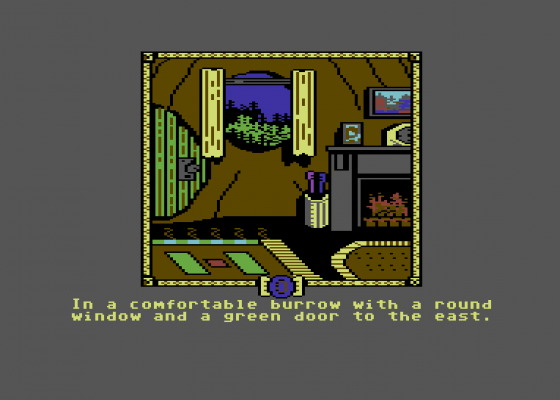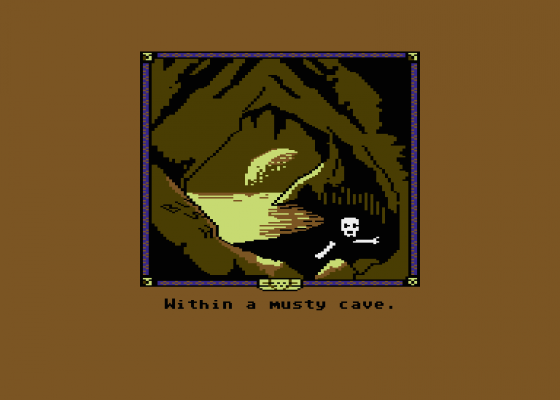
Computer Gamer
 1st February 1986
1st February 1986
Categories: Review: Software
Author: Gordon Hamlett
Publisher: Melbourne House
Machine: Commodore 64
Published in Computer Gamer #11
Adventures everywhere have been waiting for the game based on Tolkien's classic The Lord Of The Rings. Gordon Hamlett takes an in-depth look at Melbourne House's sequel to The Hobbit and decide it's worth the wait.
Lord Of The Rings
If a picture of a green door, a round window and a yellow chest or being told that Thorin is singing of gold brings back fond memories; if you spent sleepless nights trying to escape from the pale bulbous eyes or working out how to get out of the goblin's dungeon,, then you are obviously a devoted fan of Melbourne House's superb adventure game, The Hobbit. Almost as soon as it was released, people wanted to know if Melbourne House were going to do Lord Of The Rings and when it would be ready. Well, they did and it is.
Or rather, the first part of it is. Such is the complexity of Tolkien's masterpiece, there is no way that it could be compressed into one program. So, as the book is in three volumes, so will the game be and part one of Lord Of The Rings follows the plot of book one - The Fellowship Of The Ring.
The package (which is the thickest that I have come across at just under 2.5 inches) contains a copy of the book, a 32-page instruction book and two cassettes. The game is split into two parts which can be played independently although it is recommended that you complete part one first as there are certain objects and characters that could prove useful to you. There is also a beginner's version included so that you can introduce your little brother or sister (or mum and dad!) to the joys of adventuring.

You play the part of Frodo - a hobbit. You have been given a magic ring by Bilbo Baggins (the one that be found in the book/game The Hobbit). You must destroy it by taking it to Mordor, home of the evil Sauron. It is the master ring of the twenty magic rings fashioned in ancient times. "One ring to rule them all, one ring to find them, one ring to bring them all and in the darkness bind them" as the poem from Elven lore reads. The ring can only be destroyed in the Crack of Doom (although you won't reach there until game three). It has considerable powers, such as making the bearer invisible when worm but be warned, the more you use it, the more you will fall under its evil spell. Sauron has discovered that you have the ring and desperately wants it back.
You are not expected to perform this momentous task alone. Three of your friends agree to help you. Sam and Pippin are present at the start and you should meet Merry later on. You will also meet many other characters in the course of the story but at all times, avoid the Black Riders (also known as the Nazgul or Ring Wraiths) who are Sauron's evil minions. Sam, Pippin and Merry are controlled either by the computer, yourself or your friends. At the start of the game, you are asked which characters you want to play. If you choose to play the other characters as well as Frodo, you can swap between them using the "BECOME XXXX" command. I would strongly recommend letting the computer play these characters until you have a very good idea of what's going on.
Part one of the game starts with you in your burrow. A message from Gandalf the Wizard says "See you in Rivendell. Matter is urgent. Watch out for the Black Riders." You have to make your way to the town of Bree meeting perhaps en route Farmer Maggot, Merry, Tom Bombadil and Strider whilst avoiding a malicious willow tree and a barrow wight. There is no guarantee that you will meet all of the above for you can wander where you want - there is no set path to follow. Once at Bree, you will need to find someone to guide you through the marshes. The game contains some fiendish mazes but most of these can be avoided if you know how.

Part two sees you fording the river with the Black Riders trying to stop you as you head towards Elrond in Rivendell. There, you gain some travelling companions as you make your way through Moria in the Misty Mountains towards Lothlorien, fighting water monsters and vicious tribes of orcs.
There are two main problems in translating Tolkien from book to computer. The first is to maintain the spirit of the original story but create sufficient new problems so that it is not an exact copy of the book's plot. The second problem is that not a great deal of action happens in the first book in the way of problems that need to be solved.
As far as the first problem is concerned, the game creates a good atmosphere but there are one or two exceptions. Consider this location description: "You are in a dimly lit room crammed with various beings drinking and dancing to the music of an incredibly loud heavy metal orc band." I dread to think what Professor Tolkien would have thought of that... which is more suitable to the parody Bored Of The Rings than the real thing!

The first adventure does not contain many difficult problems to be solved but there are a large number of locations to be explored. Mapping must be done very carefully. At the time of writing, I have eleven sheets of foolscap covered with assorted bits of maps and redrawn maps. I started off feeling that it all lacked substance but it builds to a fine climax and the midnight oil was soon getting low. Part two suffers from none of this. You are straight into the action and everything moves at a great pace.
You spend a lot of time in the adventure interacting with other characters. A quick hello will usually start the conversation going or you can ask specific people to do a given task such as "Say to Sam 'Take the rope'". Sam may or may not do this depending on the nature of the request and how he feels at the time. Everybody needs to eat regularly and you will always be on the lookout for your next meal. How characters behave depends on how well fed they are. Things tend to go quite slowly on screen especially if you have 8 or 9 characters present and the computer is trying to sort out what everyone is doing.
The game supports an excellent vocabulary of some 800 words but some of the verbs that the instruction book says are understood do not appear to be so. For example, you have no idea of how well you are doing because the computer does not recognise the word "score" as is claimed. Similarly, in the beginner's game, you can ask for help but must do this by typing "hint" instead of "help" as instructed.

There are several bugs in the game, as is only to be expected in a program of this complexity. They do not however crop up every time you play. Most of them are minor but some are more annoying. On one occasion, I picked up a short sword which subsequently appeared on my inventory but when I tried to give it to Pippin, the computer replied that I did not possess it. Of course, when I tried to verify the bug in the next game, it did not happen! I suspect that was with The Hobbit, people will be writing in for a long time to come saying that this or that is wrong.
Some of the locations are illustrated, but it is hard to imagine why as the pictures are few and far between and of a much poorer quality than those in the Hobbit and they add nothing to the atmosphere. There are quite a few pictures in the beginner's game, which is fair enough. Most of these disappear in part one, and I have not yet come across any in part two.
The beginner's game is an excellent idea to give you a gentle introduction to the noble art of adventuring. All you have to do is to get Frodo and his friends safely to the town of Bree. All the problems have been simplified or omitted and you can get a hint if you are really stuck. It has also been written so that when you solve the easy version, it won't ruin the main game for you.

Both parts of the program are so complex, that you must reload the game whenever you die or quit because you are stuck. At first, I found this extremely annoying, but as I became more and more engrossed in the game, I couldn't care less. This attitude continued throughout the game. I started off thinking that it was not as good as The Hobbit and was too easy. Then I realised that this was because of the nature of the book rather than any fault with the game. Certainly there are bits of it that I found extremely annoying and which will irritate fans of the book enormously but by then I was hooked and could forgive it almost anything.
Lord Of The Rings is a worthy successor to The Hobbit and is, in my opinion, Melbourne House's best adventure to date. A classic. A flawed classic, but a classic nonetheless.
The Lord Of The Rings is available for the Spectrum for £15.95 and wll also be published for the C64, Amstrad and BBC formats. Well worth raiding the piggy bank for.




















